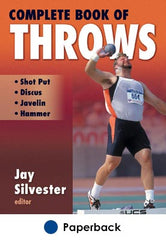Javelin Throwing Techniques
This is an excerpt from Complete Book of Throws by Jay Silvester.
Consistent in each of the throwing events are three critical factors that influence the distance thrown:
- Speed of release
- Angle of release
- Height of release
The last two are measured with the ground as the reference point. They are prioritized in the order listed; the speed of release is most important, followed by release angle, then release height. It is important to remember that sound technique controls all three critical factors so that as you become more proficient, you will improve in all of these areas, not just one. The throwing technique you use must allow the application of physical ability (speed, power, and rhythm) into all three of these areas. With proper technique you do not “throw” the javelin with your arm alone; rather, you “pull” or “sling” it through the combined effort of your entire body.
The mechanics of delivering the javelin are a summation of forces that begin from the ground and work up the body as energy is transferred from one body part to the next and ultimately into the spear. The analogy of “cracking a whip” is very descriptive of the action of the throw. Basically you want to pull the javelin over as long a distance in as short a time as possible. The movements involved break down as follows (all descriptions are for a right-handed thrower):
- After a run-up that generates momentum, pull the throwing arm back with your hand at or slightly higher than shoulder height; turn your body somewhat sideways.
- As you land on your right foot before the throw, bend your right knee—the “soft step”—to allow your body weight and run momentum to continue moving forward without slowing. Keep your throwing arm back and straight while extending your left arm toward the throw direction for balance; extend your left leg forward as well, waiting for the ground contact.
- Pass your body weight quickly over your right foot and make impact with your left foot. The action of your left side is that of a brace or fulcrum; it anchors firmly to accelerate the right side into the release. Before ground contact turn your right heel out and bring the left elbow over the left foot. These actions are simultaneous and both are complete at the instant of left side bracing.
- The bracing action causes a series of stretch reflexes that progress upward in your body; first your right hip rotates forward, then stops. That, in turn, pulls your ribs and chest forward, stretching your shoulder as your arm remains behind. Your chest stabilizes and your shoulder is whipped up and over the body, with your arm following.
- As your arm starts to strike, turn up and bend your elbow, much like a tennis serve, and quickly extend it as your shoulder gives a base to act on. Your arm and hand continue to accelerate after you have released the javelin. The throwing hand often slaps the left thigh as it finishes the throw.
The overall impression of the throwing action is that of an explosive, horizontal movement. Key concepts that coaches and athletes should focus on to refine technique are as follows:
- Maintained or increased momentum from the run-up into the throw
- Backward lean as the legs “run away” from the upper body
- Initiation of the throw from the legs
- Separation of the hip and shoulder axes
- Firm bracing from the left side
- Delayed arm strike


Get the latest insights with regular newsletters, plus periodic product information and special insider offers.
JOIN NOW


